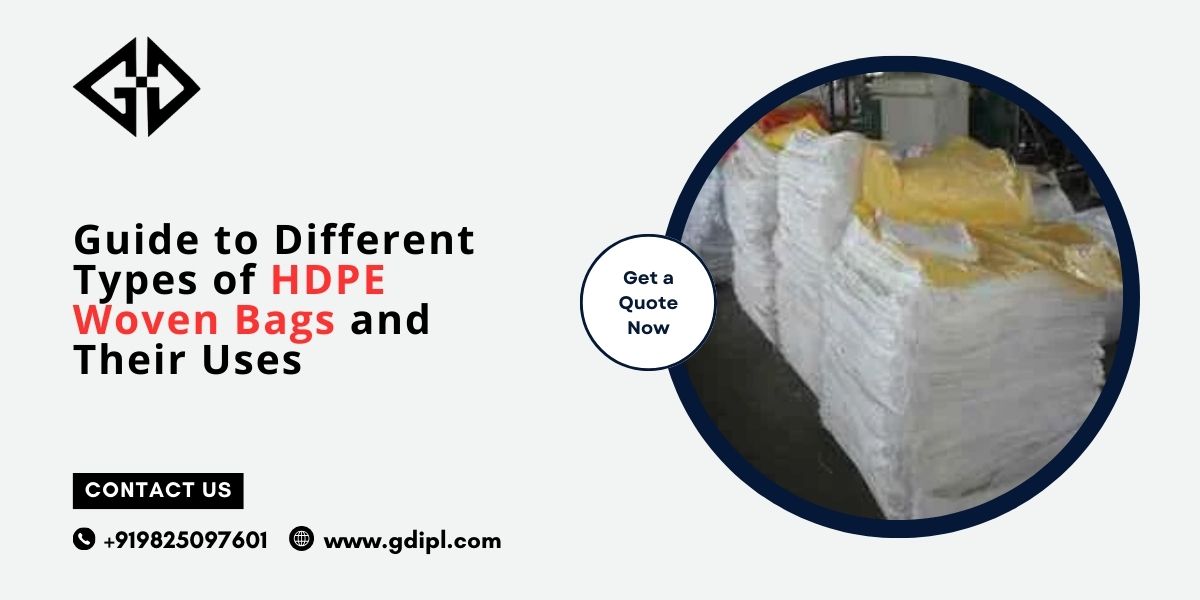
In today's fast-moving industrial and commercial environments, packaging is more than just a protective layer—it's an essential part of logistics, storage, and product presentation. One packaging solution that continues to gain popularity across sectors is the HDPE woven bag. These bags are valued for their strength, flexibility, cost-effectiveness, and versatility. But not all woven bags are the same. In this guide, we’ll explore the different types of HDPE woven bags available and their specific uses across various industries.
What Are HDPE Woven Bags?
HDPE woven bags are made from High-Density Polyethylene, a thermoplastic polymer known for its strength-to-density ratio. These bags are manufactured by weaving HDPE strips together to form a tight, durable fabric that can handle heavy loads without tearing or losing shape. The woven structure not only enhances durability but also allows breathability, which is especially important in industries like agriculture and food storage.
These bags are widely used in agriculture, chemicals, food grains, cement, and retail sectors for storing and transporting materials safely and efficiently.
Types of HDPE Woven Bags
There are several variations of HDPE woven bags, each tailored for specific purposes. Below are the most commonly used types:
1. Plain HDPE Woven Bags
Plain HDPE woven bags are the most basic form of woven packaging. They are typically white or natural in color and do not have any lamination. These are ideal for dry goods like grains, pulses, and seeds. Because they’re breathable, they help in preventing moisture buildup inside the bag.
Common uses:
- Storing grains and seeds
- Agricultural produce
- Lightweight industrial components
2. Laminated HDPE Woven Bags
Laminated HDPE woven bags are coated with a protective plastic layer (usually BOPP or LDPE), which makes them water-resistant and more durable. This type of bag is ideal for materials that need protection from moisture or contamination.
Common uses:
- Packaging cement, fertilizers, and chemicals
- Food-grade materials like flour and sugar
- Animal feed
3. Gusseted HDPE Woven Bags
Gusseted bags are designed to expand when filled, offering more internal space and better shape retention. These bags sit flat and are easier to stack, making them a favorite for warehouse storage.
Common uses:
- Retail packaging
- Bulk materials with variable volume
- Products that require shelf-friendly packaging
4. Valve Type HDPE Woven Bags
These bags feature a valve for filling, which makes them ideal for automated packing processes. The valve automatically closes after filling, reducing labor time and improving efficiency.
Common uses:
- Cement and construction materials
- Powdered chemicals
- Dry industrial products
5. Transparent or Semi-Transparent HDPE Woven Bags
These bags are useful when the visibility of the contents is important. Though not as strong as laminated bags, they’re perfect for packaging products where visual inspection is frequently required.
Common uses:
- Retail packaging
- Agricultural products
- Plastic granules
6. Printed HDPE Woven Bags
Printed HDPE woven bags allow for branding and labelling, which is a great advantage for companies looking to promote their brand. These bags can be printed with logos, product details, and handling instructions.
Common uses:
- Retail and wholesale product packaging
- Branded grain or flour bags
- Promotional packaging
HDPE PP Woven Bags vs. PP HDPE Woven Bags
You might often come across terms like HDPE PP woven bags or PP HDPE woven bags in the market. While both types use Polypropylene (PP) and High-Density Polyethylene (HDPE), the manufacturing process and usage vary slightly based on the material blend ratio.
- HDPE-based woven bags tend to be stronger and more flexible.
- PP-based woven bags are lighter and offer a smoother surface, making them better suited for high-quality printing.
The choice between the two depends on the intended application. For heavier loads and rough handling, HDPE woven bags are ideal. If appearance and print quality are a priority, PP variants may be preferred.
Why Choose a Trusted HDPE Woven Bag Manufacturer?
When it comes to industrial packaging, choosing the right supplier is as important as selecting the right type of bag. A reputable HDPE woven bag manufacturer ensures consistent quality, customization options, and timely delivery. Poor-quality bags can lead to product damage, logistical issues, and even regulatory compliance problems in sectors like food or chemicals.
GDIPL, a trusted name in the packaging industry, offers a wide range of HDPE woven bags suitable for diverse applications. With years of manufacturing expertise, strict quality control, and client-first service, GDIPL ensures your packaging requirements are met with professionalism and precision.
Advantages of Using HDPE Woven Bags
To summarize, here are the key benefits of using HDPE woven bags:
- High strength-to-weight ratio
- Reusable and recyclable, promoting sustainability
- Moisture resistance (especially when laminated)
- Customizable in terms of size, print, and finish
- Cost-effective for bulk packaging
Whether you're in agriculture, manufacturing, construction, or retail, these bags offer a solution that is both practical and eco-conscious.
Final Thoughts
HDPE woven bags are an indispensable part of the modern packaging world. From plain storage solutions to printed, gusseted, or laminated bags, each type is designed with a purpose—and choosing the right one can significantly enhance your operational efficiency.
If you’re looking for dependable packaging that combines strength, sustainability, and customizability, HDPE woven bags are an excellent choice. And when it comes to quality you can trust, GDIPL stands out as a reliable HDPE woven bag manufacturer that understands the nuances of different industries.
Contact us today to explore our full range of HDPE woven bag solutions or to request a custom quote for your packaging needs.